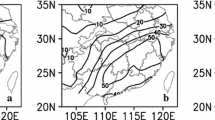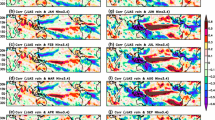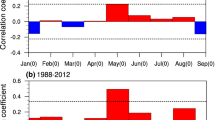Abstract
In this paper, the east–west tropical ‘Walker circulation’ and its linear association with sea surface temperature (SST) of the Nino 3 region and Indian summer monsoon rainfall (ISMR) have been investigated. ‘Walker circulation’/‘reverse Walker circulation’ is primarily forced by SSTs of the equatorial Pacific Ocean. In this study, velocity potential field of 0.21 sigma level over the tropics was considered as proxy of the zonal tropical circulation (‘Walker circulation’/‘reverse Walker circulation’). Principal component analysis of the monsoon season tropical velocity potential data of 0.21 sigma level for the two periods 1951–1980 and 1981–2010, was done separately. We find that earlier, two different patterns of the velocity potential field, forced by probably two distinct modes of El Nino episodes, were associated with the ISMR. These two El Nino episodes, respectively, correspond to the strong El Nino events, where in warming was extended up to the date line (primarily zonal) and the moderate El Nino events in which, warming having north south extension, was limited to the eastern Pacific Ocean only. However, in recent years, only the first pattern of the velocity potential field, induced by the strong El Nino events (warming extending up to the date line), was correlated with the ISMR. Further, in the later period (1981–2010), velocity potential field at 0.21 sigma level over the tropical Pacific and Indian Oceans, which appeared to be primarily driven by SST anomalies of the equatorial Pacific Ocean in the first period, was found to be significantly correlated with the extra tropical circulation anomalies also. Therefore, modulation of the ISMR through velocity potential field over the tropical Indian and Pacific Oceans, in the later period, may have additional significant impact of the extra-tropical circulation anomalies. This might have led weak correlation between the ISMR and SSTs of the Nino 3 region, which is actually being observed in recent years.















Similar content being viewed by others
References
Annamalai H, Liu P (2005) Response of the Asian summer monsoon to changes in El-Nino properties. Q J Meteorol Soc 131:805–831
Bollasina MA, Ming Y, Ramaswamy V (2011) Anthropogenic aerosols and the weakening of the south Asian summer monsoon. Science 28:333–502
Chang CP, Patrick H, Ju J (2001) Possible roles of Atlantic circulations on the weakening Indian monsoon rainfall ENSO relationship. J Clim 14:2376–2380
Ding Q, Wang B (2005) Circimglobal teleconnection in the northern hemisphere summer. J Clim 18:3483–3505
Ding Q, Wang B (2007) Intra-seasonal teleconnection between the summer Eurasian wave Train and the Indian monsoon. J Clim 20:3571–3767
Gershunov A, Schnelder N, Barnett T (2001) Low frequency modulation of the ENSO–Indian monsoon rainfall relationship: signal or noise? J Clim 14:2486–2492
Goswami BN (2004) Interdecadal change in potential predictability of the Indian summer monsoon. Geophys Res Lett 31(L16):208. doi:10.1029/2004GL020,337
Goswami BN, Xavier PK (2005) ENSO control on the south Asian monsoon through the length of the rainy season. Geophys Res Lett 32:L18717. doi:10.1029/2005GL023216
Guhathakurta P, Rajeevan M, Sikka DR, Tyagi A (2014) Observed changes in SW monsoon rainfall over India during 1901–2011. J Climatol. doi:10.1002/JOC.4095
Kalnay K, Kanamitsu M, Kistler R, Collins W, Deaven D, Gandin L, Iredel M, Saha S, White G, Woollen J, Zhu Y, Chelliah M, Ebisuzaki W, Higgins W, Janowiak J, Mo KC, Ropelewski C, Wang J, Leetmaa A, Reynolds R, Jenne R, Joseph D (1996) The NCEP/NCAR 40-year reanalysis project. Bull Am Meteorol Soc 77:437–471
Keshavamurty RN (1982) Response of the atmosphere to sea surface temperature anomalies over the equatorial Pacific and the teleconnections of the southern oscillation. J Atmos Sci 39:1241–1259
Kriplani RH, Kulkarni A (1997) Climatic impact of El-Nino/La Nina on the Indian monsoon: a new perspective. Weather 52:39–46
Krishna Kumar K, Rajagopalan B, Cane MA (1999) On the weakening relationship between the Indian monsoon and ENSO. Science 284:2156–2159
Krishna Kumar K, Rajagopalan B, Hoerling M, Bates G, Cane M (2006) Unravelling the mystery of Indian monsoon failure during El Nino. Science. doi:10.1126/science.1131152
Krishnamurthy V, Goswami BN (2000) Indian monsoon–ENSO relationship on inter decadal time scales. J Clim 13:579–595
Krishnamurti TN (1971) Tropical east–west circulations during the northern summer. J Atmos Sci 26:1342–1347
Miyakoda K, Kinter JL III, Yang S (2003) The role of ENSO in the South Asian monsoon and pre-monsoon signals over the Tibetan Plateau. J Meteorol Soc Jpn 81:1015–1039
Mooley DA, Parthasarthy B (1983) Indian summer monsoon and El-Nino. PAGEOPH 121:339–352
Nitta T, Yamada S (1989) “Recent warming of tropical surface temperature and its relationship to the northern hemisphere circulation. J Meteorol Soc Jpn 67:375–383
Normand CWB (1953) Monsoon seasonal forecasting. Q J R Meteorol Soc 79:463–473
Pant GB, Parthasarthy B (1981) Some aspects of an association between the southern oscillation and Indian summer monsoon. Arch Meteorol Geophys Biokl Ser B 29:245–251
Raman CRV, Rao YP (1981) Blocking highs over Asia and droughts over India. Nature 289:271–273
Rasmusson EM, Carpenter TH (1983) The relationship between eastern equatorial Pacific sea surface temperature and rainfall over India and Sri Lanka. Mon Weather Rev 111:517–528
Sikka DR (1980) Some aspects of the large scale fluctuations of summer monsoon rainfall over India in relation to fluctuations in the planetary and regional scale circulation parameters. Proc Indian Acad Sci Earth Planet Sci 89:179–195
Srivastava AK, Guhathakurta P, Rajeevan M, Dikshit SK, Kshirsagar SR (2007) Did unusual warming over the mid and higher latitudes cause unprecedented failure of southwest monsoon during July 2002? Meteorol Atmos Phys 96(3–4):193–201
Srivastava AK, Somenath Dutta, Kshirsagar SR, Srivastava K (2014) Has influence of extra tropical waves in modulating Indian summer monsoon rainfall (ISMR) increased? J Earth Syst Sci 123(3):445–456
Torrence C, Webster PJ (1999) Interdecadal changes in the ENSO–monsoon system. J Clim 12:2679–2690
Van Oldenborgh GJ, Burgers G (2005) Searching for decadal variations in ENSO precipitation teleconnections. Geophys Res Lett 32:L15701. doi:10.1029/2005GL023110
Walker GT (1924) “Correlation in seasonal variations of weather, IV”, a further study of world weather. Mem India Meteorol Dept 24:275–332
Wang B (1995) Interdecadal changes in El Nino onsetin the last four decades. J Clim 8:267–285
Xavier PK, Marzin C, Goswami BN (2007) An objective definition of the Indian summer monsoon season and a new perspective on ENSO–monsoon relationship. Q J Meteorol Soc 133:749–764
Yasunari T (1987a) Global structure of El-Nino/southern oscillation. Part I: El-Nino composites. J Meteorol Soc Jpn 65:67–80
Yasunari T (1987b) Global structure of El-Nino/southern oscillation. Part II: time evolution. J Meteorol Soc Jpn 65:81–102
Acknowledgments
Authors are grateful to the DGM, IMD for providing necessary facilities for the study. They are thankful to Sri B. Mukhopadhyay, ADGM(R) for providing constant encouragement. Thanks are also due to Smt. U. J. D’souza for typing the manuscript.
Author information
Authors and Affiliations
Corresponding author
Rights and permissions
About this article
Cite this article
Srivastava, A.K., Srijith, O.P., Kshirsagar, S.R. et al. Has modulation of Indian summer monsoon rainfall by sea surface temperature of the equatorial Pacific Ocean, weakened in recent years?. Clim Dyn 45, 2237–2254 (2015). https://doi.org/10.1007/s00382-015-2470-z
Received:
Accepted:
Published:
Issue Date:
DOI: https://doi.org/10.1007/s00382-015-2470-z




